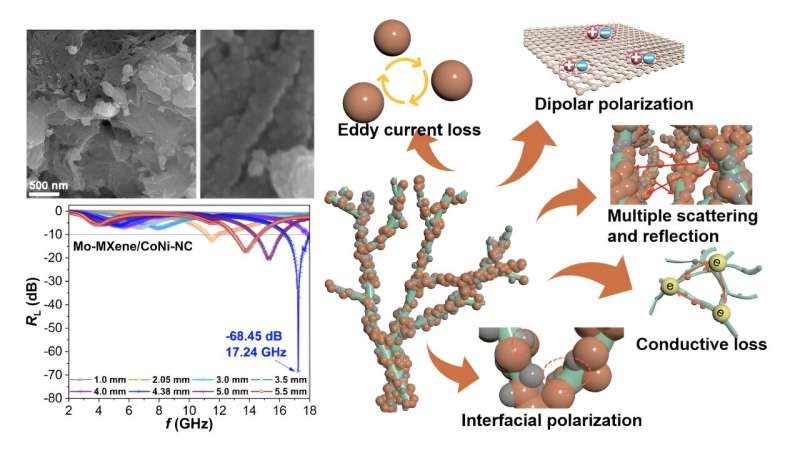This article has been reviewed according to Science X's editorial process and policies. Editors have highlighted the following attributes while ensuring the content's credibility:
fact-checked
proofread
Construction of dual heterogeneous interface between zigzag-like Mo-MXene nanofibers and small CoNi@NC nanoparticles

Two-dimensional transition metal carbides (MXene) possess attractive conductivity and abundant surface functional groups, providing immense potential in the field of electromagnetic wave (EMW) absorption. However, high conductivity and spontaneous aggregation of MXene suffer from limited EMW response. Inspired by dielectric–magnetic synergy effect, the strategy of decorating MXene with magnetic elements is expected to solve this challenge.
Recently, Professor Xiaojun Zeng of Jingdezhen Ceramic University and Professor Bingbing Fan of Zhengzhou University collaborated on the development of a Mo-MXene/CoNi-NC double heterogeneous interface material composed of zigzag-like Mo-MXene nanofibers and CoNi@NC nanoparticles.
Benefiting from the synergistic effect of highly dispersed small CoNi alloy nanoparticles, a three-dimensional conductive network assembled by zigzag-like Mo–MXene NFs, numerous N-doped hollow carbon vesicles, and abundant dual heterogeneous interface, the Mo-MXene/CoNi-NC heterostructure designed provides a strong EMW absorption capability, which provides a great potential for the development of advanced EMW absorption devices based on MXene.
In this work, zigzag-like Mo2TiC2–MXene nanofibers (Mo-based MXene (Mo–MXene) NFs) with cross-linked networks are fabricated by hydrofluoric acid etching and potassium hydroxide shearing processes. Subsequently, a dual heterogeneous interface is constructed by mixing zigzag-like Mo–MXene NFs with small CoNi@NC nanoparticles by the coprecipitation method, ion exchange process, and heat-treatment strategy.
The Mo-MXene/CoNi-NC heterostructures exhibit excellent EMW absorption properties. The paper's corresponding author, Jingdezhen Ceramic University School of Materials Science and Engineering Professor Xiaojun Zeng, said.
The team published their work in Journal of Advanced Ceramics.
The designed Mo-MXene/CoNi-NC heterostructure provides strong electromagnetic wave absorption capability, with an RL value as high as −68.45 dB at a matching thickness of 4.38 mm. The excellent EMW absorption performance can be attributed to outstanding impedance matching, magnetic loss, dielectric loss, as well as multiple scattering and reflection caused by the unique 3D network structure.
"Inspired by dielectric–magnetic synergy effect, the strategy of decorating MXene with magnetic elements is expected to resolve the problem of impedance mismatch caused by the high conductivity of MXene," Xiaojun Zeng said.
The next step is to expand the variety of Mo2TiC2 MXene-based EMW absorption materials by employing various methods for constructing heterogeneous structures and systematically evaluate the absorption mechanism of MXene-based EMW absorption materials. The ultimate goal is to establish a new theoretical system based on Mo2TiC2 MXene heterogeneous structures.
More information: Xiaojun Zeng et al, Construction of dual heterogeneous interface between zigzag-like Mo–MXene nanofibers and small CoNi@NC nanoparticles for electromagnetic wave absorption, Journal of Advanced Ceramics (2023). DOI: 10.26599/JAC.2023.9220772
Provided by Tsinghua University Press




















